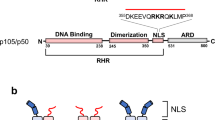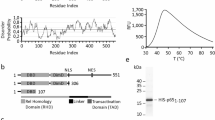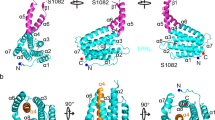Abstract
The crystal structure of the NF-κB p65 (RelA) homodimer in complex with a DNA target has been determined to 2.4 Å resolution. The two p65 subunits are not symmetrically disposed on the DNA target. The homodimer should optimally bind to a pseudo-palindromic nine base pair target with each subunit recognizing a 5′GGAA-3′ half site separated by a central A–T base pair. However, one of the subunits (subunit B) encounters a half site of 5′-GAAA-3′. The single base-pair change from G–C to A–T results in highly unfavorable interactions between this half site and the base contacting protein residues in subunit B, which leads to an 18° rotation of the N-terminal terminal domain from its normal conformation. Remarkably, subunit B retains all the interactions with the sugar phosphate backbone of the DNA target. This mode of interaction allows the NF-κB p65 homodimer to recognize DNA targets containing only one cognate half site. Differences in the sequence of the other half site provide variations in conformation and affinity of the complex.
This is a preview of subscription content, access via your institution
Access options
Subscribe to this journal
Receive 12 print issues and online access
$189.00 per year
only $15.75 per issue
Buy this article
- Purchase on Springer Link
- Instant access to full article PDF
Prices may be subject to local taxes which are calculated during checkout
Similar content being viewed by others
References
Baeurle, P.A. & Henkel, T. Function and activation of NF-kappa B in the immune system. Annu. Rev. Immunol. 12, 141–179 (1994).
Baldwin, A.S., NF-kappa B and I kappa B proteins: new discoveries and insights. Annu. Rev. Immunol. 14, 649–683 (1996).
Siebenlist, U., Franzoso, G. & Brown, K., Structure, regulation and function of NF-kappa B. Annu. Rev. Cell. Biol. 10, 405–455 (1994).
Grilli, M., Chiu, J.J. & Lenardo, M.J. NF-kappa B and Rel: participants in a multiform transcriptional regulatory system. Int Rev Cytol 143, 1–62 (1993).
Kunsch, C., Ruben, S.M. & Rosen, C.A. Selection of optimal kappa B/Rel DNA-binding motifs: interaction of both subunits of NF-kappa B with DNA is required for transcriptional activation. Mol Cell Biol 12, 4412–4421 (1992).
Casoiaro, V. et al. Inhibition of NF-AT-dependent transcription by NF-kappa B: implications for differential gene expression in T helper cell subsets. Proc. Natl. Acad. Sci. USA 92, 11623–11627 (1995).
Ghosh, G., van Duyne, G., Ghosh, S. & Sigler, P.B. Structure of NF-kappa B p50 homodimer bound to a kappa B site. Nature 373, 303–310 (1995).
Muller, C.W., Rey, F.A., Sodeoka, M., Verdine, G.L. & Harrison, S.C. Structure of the NF-kappa B p50 homodimer bound to DNA. Nature 373, 311–317 (1995).
Thanos, D. & Maniatis, T. Identification of the rel family members required for virus induction of the human beta interferon gene. Mol. Cell. Biol. 15, 152–164 (1995).
Huang, D.-B., Huxford, T., Chen, Y.-Q. & Ghosh, G. The role of DNA in the mechanism of NFkB dimer formation: crystal structures of the dimerization domains of the p50 and p65 subunits. Structure 5 1427–1436 (1997).
Falvo, J.V., Thanos, D. & Maniatis, T. Reversal of intrinsic DNA bends in the IFN beta gene enhancer by transcription factors and the architectural protein HMG I(Y). Cell 83, 1101–1111(1995).
Bell, S., Matthews, J.R., Jaffray, E. & Hay, R.T. l(kappa)B(gamma) inhibits DNA binding of NF-kappaB p50 homodimers by interacting with residues that contact DNA. Mol. Cell. Biol. 16, 6477–6485 (1996).
Bressler, P. et al. Mutational analysis of the p50 subunit of NF-kappa B and inhibition of NF-kappa B activity by trans-dominant p50 mutants. J. Virol. 67, 288–293 (1993).
Coleman, T.A., Kunsch, C., Maher, M., Ruben, S.M. & Rosen, C.A. Acquisition of NFKB1-selective DNA binding by substitution of four amino acid residues from NFKB1 into RelA. Mol. Cell. Biol. 13, 3850–3859 (1993).
Toledano, M.B., Ghosh, D., Trinh, F. & Leonard, W.J. N-terminal DNA-binding domains contribute to differential DNA-binding specificities of NF-kappa B p50 and p65. Mol. Cell. Biol. 13, 852–860 (1993).
Kumar, S., Rabson, A.B. & Gelinas, C., RxxRxRxxC motif conserved in all Rel/kappa B proteins is essential for the DNA-binding activity and redox regulation of the v-Rel oncoprotein. Mol Cell Biol 12, 3094–3106 (1992).
Ledebur, H.C. & Parks, T.P. Transcriptional regulation of the intercellular adhesion molecule-1 gene by inflammatory cytokines in human endothelial cells. Essential roles of a variant NF-kappa B site and p65 homodimers. J Biol Chem 270, 933–943 (1995).
Sica, A. et al. The c-rel protooncogene product c-Rel but not NF-kappa B binds to the intronic region of the human interferon-gamma gene at a site related to an interferon-stimulable response element. Proc Natl Acad Sci U S A 89, 1740–1744 (1992).
Collart, M.A., Baeuerle, P. & Vassalli, P. Regulation of tumor necrosis factor alpha transcription in macrophages: involvement of four kappa B-like motifs and of constitutive and inducible forms of NF-kappa B. Mol. Cell. Biol. 10, 1498–1506 (1990).
Hansen, S.K., Guerrini, L. & Blasi, F. Differential DNA sequence specificity and regulation of HIV-1 enhancer activity by cRel-RelA transcription factor. J. Biol. Chem. 269, 22230–22237 (1994).
Whitley, M.Z., Thanos, D., Read, M.A., Maniatis, T. & Collins, T. A striking similarity in the organization of the E-selectin and beta interferon gene promoters. Mol. Cell. Biol. 14, 6464–6475 (1994).
Xu, X. & Gelinas, C. A mutant Rel-homology domain promotes transcription by p50/NFkappaB1. Oncogene 14, 1521–1530 (1997).
Fujita, T., Nolan, G.P., Ghosh, S. & Baltimore, D. Independent modes of transcriptional activation by the p50 and p65 subunits of NF-kappa B. Genes Dev 6, 775–787 (1992).
LeClair, K.P., Blanar, M.A. & Sharp, P.A. The p50 subunit of NF-kappa B associates with the NF-IL6 transcription factor. Proc Natl Acad Sci U S A 89, 8145–8149 (1992).
Stein, B. et al. Cross-coupling of the NF-kappa B p65 and Fos/Jun transcription factors produces potentiated biological function. EmboJ 12, 3879–3891 (1993).
Sif, S. & Gilmore, T.D. Interaction of the v-Rel oncoprotein with cellular transcription factor Sp1. J. Virol. 68, 7131–7138 (1994).
Lefstin, J.A., Thomas, J.R. & Yamamoto, K.R. Influence of a steroid receptor DNA-binding domain on transcriptional regulatory functions. Genes Dev 8, 2842–2856 (1994).
Walker, S., Hayes, S. & O′Hare, P.Site-specific conformational alteration of the Oct-1 POU domain-DNA complex as the basis for differential recognition by Vmw65 (VP16). Cell 79, 841–852 (1994).
Yin, M.J. & Gaynor, R.B. HTLV-1 21 bp repeat sequences facilitate stable association between Tax and CREB to increase CREB binding affinity. J Mol Biol 264, 20–31 (1996).
Otwinoswki, Z., Oscillian Data Reduction Programme, in Proceedings of the CCP4 Study Weekend: “Data Collection and Processing,” 29–30 January 1993, (Compiled by: L. Sawyer, N. Issacs S. Bailey) 56–62 (SERC Daresbury Laboratory, England)
Brunger, A.T. X-PLOR Version 3.1: A system for x-ray crystallography and NMR, 382 (Yale University Press, New–Heaven, 1992
Collaborative Computing Project, No. 4 (1994). The CCP4 suite: programs for protein crystallogy. Acta Cryst. D50, 760–763.
Evans, S.V. SETOR: hardware-lighted three-dimensional solid model representations of macromolecules.J. Mol. Graph. 11, 134–138 (1993).
Lavery, R. & Sklenar, H. The definition of generalized helicoidal parameters and of axis curvature for irregular nucleic acids. J. Biomol. Struct. Dyn. 6, 63–91 (1988).
Himes, S.R., Coles, L.S., Katsikeros, R., Lang, R.K. & Shannon, M.F. HTLV-1 tax activation of the GM-CSF and G-CSF promoters requires the interaction of NF-kB with other transcription factor families. Oncogene 8, 3189–3197 (1993).
Himes, S.R., Coles, L.S., Reeves, R. & Shannon, M.F. High mobility group protein I(Y) is required for function and for c-Rel binding to CD28 response elements within the GM-CSF and IL-2 promoters. Immunity 5, 479–489 (1996).
Ghosh, P., Tan, T.H., Rice, N.R., Sica, A. & Young, H.A. The interleukin 2 CD28-responsive complex contains at least three members of the NF kappa B family: c-Rel, p50, and p65. Proc Natl Acad Sci U S A 90, 1696–1700 (1993).
Parry, G.C. & Mackman, N. A set of inducible genes expressed by activated human monocytic and endothelial cells contain kappa B-like sites that specifically bind c-Rel-p65 heterodimers.J Biol Chem 269, 20823–20825 (1994).
Author information
Authors and Affiliations
Corresponding author
Rights and permissions
About this article
Cite this article
Chen, YQ., Ghosh, S. & Ghosh, G. A novel DNA recognition mode by the NF-κB p65 homodimer. Nat Struct Mol Biol 5, 67–73 (1998). https://doi.org/10.1038/nsb0198-67
Received:
Accepted:
Issue Date:
DOI: https://doi.org/10.1038/nsb0198-67
This article is cited by
-
Phytochemical mediated modulation of COX-3 and NFκB for the management and treatment of arthritis
Scientific Reports (2023)
-
Preliminary verification of the anti-hypoxia mechanism of Gentiana straminea maxim based on UPLC-triple TOF MS/MS and network pharmacology
BMC Complementary Medicine and Therapies (2022)
-
Fluorescent thermal shift-based method for detection of NF-κB binding to double-stranded DNA
Scientific Reports (2021)
-
Transcription factors involved in basal immunity in mammals and plants interact with the same MAMP-responsive cis-sequence from Arabidopsis thaliana
Plant Molecular Biology (2018)
-
Disruption of TWIST1-RELA binding by mutation and competitive inhibition to validate the TWIST1 WR domain as a therapeutic target
BMC Cancer (2017)



